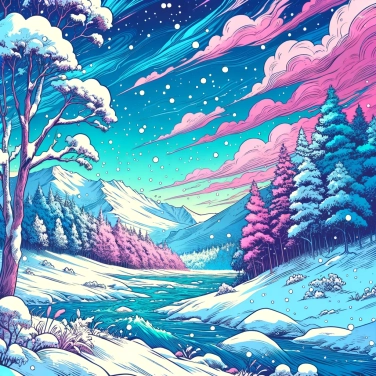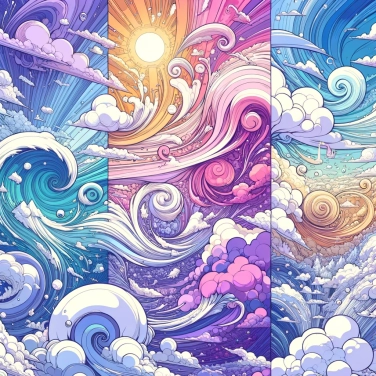Snow can sometimes appear blue due to the scattering of light. When sunlight passes through ice crystals, it is preferentially dispersed in the blue spectrum, giving snow this tint.

Snow appears white because it is made up of many tiny ice crystals. These crystals, each with their countless surfaces, reflect light in all directions, thus diffusing all the colors of the light spectrum. This intense diffusion mixes all these colors together, resulting in the typical white color you see. Essentially, snow acts a bit like many tiny mirrors that reflect all the light they receive, creating that sharp and bright impression that your eye perceives as white.
When sunlight hits snow, each crystal acts like a tiny mirror of ice. These crystals reflect, refract, and diffuse light in all directions. Generally, they send back all wavelengths of the visible spectrum, giving that usual bright white appearance. But sometimes, light rays have to travel a bit longer through the compact layers of snow. During this extra journey, certain wavelengths, especially reds and yellows, are gradually absorbed. Shorter wavelengths, like blue, then reach our eyes more easily, which explains why snow can sometimes take on a slightly bluish hue.
Snow appears blue because the white light from the sun penetrates the layer of snow and passes through the ice crystals. During this journey, the snow slightly absorbs red and yellow colors but allows blue colors of the light spectrum to pass through more easily. When the layer of snow is thick and dense, this phenomenon is amplified, and the bluish color becomes more pronounced. In fact, it's the same principle that makes glacier ice or the thick ice of icebergs appear blue. This subtle interplay between absorption and diffusion creates this lovely pastel blue shade that is so nice to observe on sunny days.
Snow often takes on bluish hues when the sky is clear and sunny. The fewer the clouds or mist, the more easily light penetrates the deep layers of snow. A thick and compact layer of snow primarily allows blue wavelengths to pass through, trapping the other colors. Late afternoon or early evening sunlight also enhances this bluish tint. Similarly, after fresh, dry, and cold snowfall, this blue coloration is more distinctly observed. In contrast, on overcast days or in fog, the snow appears more dull or gray, losing that very characteristic bright blue.
In glaciers and polar regions, it is not uncommon to see a bluish hue in the accumulated snow, especially in places where the snow is highly compacted, such as in crevasses or ice caves. For example, some explorers often notice a rich turquoise color inside the natural tunnels carved by meltwater under glaciers like Vatnajökull in Iceland or certain alpine glaciers. In areas like Antarctica, the deeply packed snow that has been there for years absorbs more of the red wavelengths of sunlight, allowing only the blue to reach our eyes. This phenomenon has also been observed in the massive thicknesses of icebergs drifting in the ocean, their compacted snow displaying very intense shades of blue. These astonishing natural displays are regularly witnessed by mountaineers, skiers, and scientists on expedition.
Glaciers often appear blue because the large amount of compact ice absorbs red and yellow wavelengths, allowing primarily blue hues to reach our eyes.
The bluish color of the snow is best observed on cloudy days or in the shade, as the absence of direct light reduces glare and allows subtle colors to become visible.
The Inuit have several dozen words to describe different types of snow, highlighting their deep knowledge and the cultural significance of snow in their environment.
When compressed under the weight of many layers, snow gradually transforms into dense, compact ice, promoting the emergence of a more pronounced bluish hue.
Fresh snow is made up of a multitude of individual crystals that reflect and scatter sunlight almost entirely in all directions equally, giving it a white appearance. It is when the snow compacts, gaining depth and density, that other wavelengths of light are absorbed more, revealing a bluish tint.
This phenomenon can occur anywhere there is enough dense and compact snow, as well as certain specific lighting conditions. However, it is more commonly observed in mountainous or polar regions where snow accumulations are greater.
The best conditions generally include very compact snow, indirect light from overcast or partially overcast skies, and deep observation such as in a crevasse, glacier, or ice cave.
Sure! Here’s the translation: "Yes, snow can occasionally display other hues such as pink or reddish (due to microscopic algae present in certain regions), yellow or gray due to atmospheric contaminants. However, these colors often indicate external elements, while blue mainly results from an optical phenomenon related to the snow itself."
No, the bluish coloration of snow is a completely natural optical phenomenon and poses no particular danger to health or the environment.

0% of respondents passed this quiz completely!
Question 1/5